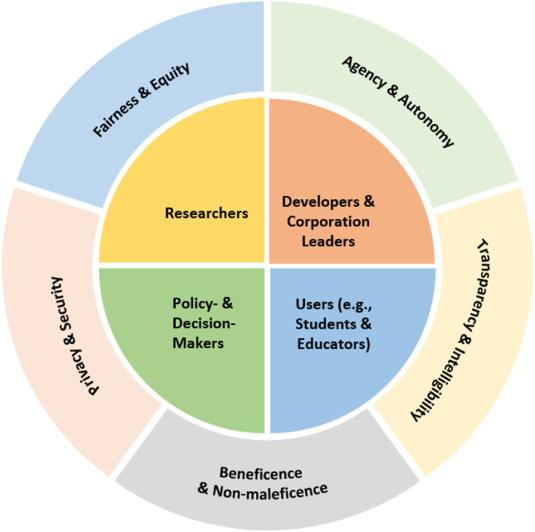Ethical Considerations of AI in Education: Safeguarding Student Rights and Integrity
Introduction
As artificial intelligence (AI) becomes an integral part of modern classrooms, it promises to revolutionize the way we teach and learn. AI-powered tools can personalize education, automate administrative tasks, and provide unique insights into student progress. However, wiht this transformative potential come meaningful ethical considerations of AI in education. Protecting student rights and ensuring the integrity of educational systems is more important than ever. In this article, we will explore the main ethical challenges, discuss strategies to safeguard student interests, highlight real-world cases, and offer practical tips for responsible AI integration in schools and universities.
Why Is AI Ethics Critically important in Education?
The adoption of AI in classrooms brings forth questions about privacy,fairness,clarity, and accountability. Educational data is both sensitive and valuable, and its misuse or mishandling can have lasting consequences for students’ futures. Ethical AI ensures not only compliance with legal standards (like GDPR or FERPA) but also fosters trust, nurtures equitable learning environments, and upholds academic integrity.as educators, policymakers, and technology developers, we all share a responsibility to embed strong ethical frameworks into every facet of AI-powered education.
Key Ethical Considerations of AI in Education
- Privacy and Data Protection: Student records contain personal and academic information. AI systems must adhere to strict privacy regulations to prevent data leaks, unauthorized access, or misuse of information.
- Bias and Fairness: Biased AI models can reinforce existing inequalities, leading to unfair grading, admissions, or disciplinary actions. Ensuring diverse and representative data sets is critical.
- Transparency and Explainability: Students, teachers, and parents should understand how educational AI makes decisions. Opaque “black box” models erode trust and accountability.
- Autonomy and Consent: Students (and their guardians) have the right to know how their data is used, and should be able to opt out when appropriate.
- Academic integrity: AI tools for assessment and plagiarism detection must balance automation with respect for honest mistakes and evolving definitions of originality.
- Accessibility and Inclusion: AI should bridge – not widen – educational divides. Systems must cater to students of all backgrounds and abilities.
Benefits of Ethical AI in Education
Ethical AI, when thoughtfully implemented, offers numerous advantages to educators and learners alike:
- Promotes fair and unbiased evaluations of student work and progress.
- Safeguards student privacy and sensitive information.
- Fosters trust in innovative learning technologies among all stakeholders.
- Helps detect and reduce academic dishonesty while supporting authentic learning growth.
- Ensures inclusivity by adapting content to diverse learner needs.
Case Studies: Ethical Dilemmas in AI-Driven Education
Case study 1: Automated Proctoring Gone Wrong
During the pandemic, many schools adopted AI-based remote proctoring to maintain academic integrity.Though,students reported false accusations of cheating due to innocuous behaviors,such as looking away from the screen or technical glitches. These cases highlighted the risks of over-reliance on AI and the importance of human oversight and appeals processes.
Case Study 2: Bias in Admissions decisions
Some universities piloted AI admission tools to process essays and applications more efficiently. Unfortunately, initial algorithms favored students from demographics with ample historical data, disadvantaging others. Upon review, developers adjusted the training data and incorporated fairness auditing to correct these imbalances.
Safeguarding Student Rights and Integrity: Best Practices
To protect student rights in AI-enhanced education, institutions and developers should embrace these actionable practices:
- Adopt Privacy by Design: integrate data protection and security features at every stage of AI system progress.
- Conduct Regular Bias Audits: Routinely test and refine algorithms for disparate impact across demographics.
- Ensure Transparency: Communicate the functions and limitations of AI tools in clear, accessible language.Offer explanatory resources and real-time support.
- Facilitate Informed Consent: Clearly explain data use policies. Seek explicit consent where necessary, and honor student/parent opt-outs.
- Empower Human Oversight: Maintain human-in-the-loop protocols so educators can review and,if needed,override AI decisions.
- promote Equity and accessibility: Design AI tools with universal design principles so all learners, including those with disabilities, are supported.
- Support Ongoing Ethics training: Provide regular workshops and training for educators, administrators, and developers on the ethical use of AI in education.
The Role of Policymakers and EdTech Developers
Building ethical AI systems in education requires collaboration between schools, technology providers, parents, and students. policymakers should craft clear guidelines grounded in real-world classroom contexts; edtech companies must prioritize ethical design and conduct transparent impact assessments. Together, these stakeholders can build an educational future where student rights and integrity are never compromised.
- Establish clear AI governance structures.
- Develop and regularly update ethical guidelines based on feedback, research, and evolving legal standards.
- Foster participatory design: Engage teachers, students, and families in shaping AI system development and deployment.
Practical tips for Educators Using AI in the Classroom
- Stay informed: Keep current with trends and debates in AI ethics in education through webinars, journals, and professional networks.
- Start small: Pilot new AI tools in limited settings, collect feedback, and iterate improvements before scaling.
- Communicate openly: Discuss AI usage, benefits, and potential risks with students and parents to build understanding and trust.
- Document processes: Retain detailed records of AI-informed decisions and the rationale behind them.
- Encourage critical thinking: Teach students about AI’s strengths and limitations, preparing them to use technology responsibly.
Conclusion: Charting an Ethical Path Forward
As AI reshapes education, its ethical dimensions demand our urgent attention. By centering student rights,privacy,and integrity,we can harness AI’s transformative potential while avoiding pitfalls. Through inclusive policies, transparent practices, ongoing training, and active stakeholder engagement, we ensure that AI in education serves every learner responsibly and respectfully. The conversation around ethical considerations of AI in education is just beginning—let’s work together to uphold the values of fairness, dignity, and trust as we build the classrooms of tommorow.

